Commercial kitchens are busy, loud environments with lots of noise and activity. When it comes to the design of these kitchens, acoustics tend to take a backseat in the design considerations. However, the sound environment of a kitchen is vital for the comfort of staff and patrons, as well as for the overall efficiency and safety of the operation.
Implementing thoughtful acoustic design can significantly reduce noise levels, building a more satisfying and productive workspace while enhancing the overall dining experience for customers. In this blog, we explore the important role that acoustics play in commercial kitchen design, and provide insights on how to effectively manage sound in a busy kitchen setting. Read on to find out more.
Why Acoustics Matter in Commercial Kitchens
The clatter of pots and pans, the hum of refrigeration units, the sizzle of cooking food – these are all familiar sounds in a commercial kitchen. However, when these sounds become overwhelming, they can create a chaotic and stressful environment. Excessive noise can impair communication among staff, leading to mistakes and decreased productivity. It can also impact the dining experience of customers in spaces where the kitchen is not completely isolated.
Acoustic Challenges in Kitchen Design
Commercial kitchens face unique acoustic challenges due to their hard surfaces and heavy-duty equipment. These surfaces easily reflect sound, contributing to a rise in overall noise levels. The challenge lies in mitigating these effects while maintaining the functionality and hygiene standards of the kitchen. Incorporating sound-absorbing materials, strategic placement of equipment, and thoughtful layout design becomes imperative to strike the right balance between a productive workspace and a noise-conscious environment.
Strategies for Improving Acoustics
In terms of steps you can take to improve acoustics, here are a few of the most popular options;
- Use of Absorbent Materials:
Integrating materials that absorb sound rather than reflect it can significantly reduce noise levels. Acoustic panels and tiles, often used in recording studios, can be strategically placed to minimise sound reflection.
- Equipment Placement and Layout:
Thoughtful arrangement of equipment and workstations can help in controlling noise distribution. Placing louder equipment away from dining areas and creating buffer zones can be effective.
- Sound-Reducing Flooring:
Floors in commercial kitchens are typically hard and reflective. Using sound-absorbing flooring materials can help in reducing noise levels without compromising on safety or cleanliness.
- Regular Maintenance of Equipment:
Well-maintained equipment tends to be quieter. Regular checks and servicing can prevent unexpected and disruptive noise from malfunctioning appliances.
- Designing with Acoustics in Mind:
From the outset, consider the acoustic impact of each design choice. This includes the layout, materials used, and even the shape of the space.
The Benefits of Good Acoustics
Improved acoustics in kitchens lead to a more pleasant and efficient work environment. It enhances communication among staff, reducing errors and improving safety. For open-plan restaurants where the kitchen is part of the dining experience, good acoustics contribute to a more enjoyable atmosphere for customers. Implementing sound-absorbing materials and strategic design elements not only builds clear communication within the kitchen but also ensures that customers can fully savour their dining experience without being overwhelmed by excessive noise from the bustling kitchen.
Balancing Acoustics with Other Design Elements
While focusing on acoustics, it’s crucial to maintain a balance with other design elements like aesthetics, functionality, and safety. The challenge is to integrate sound management solutions that complement rather than compromise the overall design and efficiency of the kitchen. Striking this delicate balance ensures that the acoustics contribute positively to the working environment without overshadowing the visual appeal, workflow, or safety considerations within the commercial kitchen.
Future Trends in Kitchen Acoustics
Advancements in materials and technology offer new possibilities in acoustic management. We may see a rise in innovative solutions that seamlessly integrate into the kitchen’s design while effectively managing sound. The future of kitchen acoustics could involve the development of cutting-edge materials and architectural concepts that not only enhance the auditory experience within the kitchen space but also contribute to a more sustainable and efficient culinary environment.
Interested in Commercial Kitchen Services?
At Advance Catering, with over 38 years in the business, we are a trusted UK provider of commercial kitchen services. Specialising in designing and installing over 100 new kitchens and refurbishing more than 50 kitchens every single year, we focus on efficiency and tailored functionality.
Our approach includes in-depth consultations, custom designs from expert chefs and consultants, quality equipment selection, and comprehensive project management. Our installation ensures compliance with industry standards and operational readiness, complemented by extensive maintenance services.
Serving a diverse range of sectors, our commitment to excellence is reflected in our satisfied clientele. If you would like to learn more, then please reach out to us today on 01582 958 300.

















